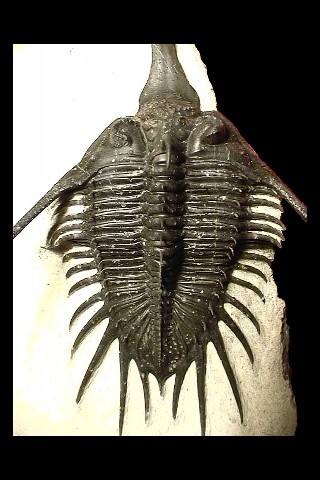Psychopyge elegans
A Devonian trilobite from Morocco : Here is a wonderful specimen, thanks to
the preparation techniques developed over the last decade. It is undoubtedly
one of the nicest specimens seen today, and required many hours of delicate
work to recover each of the spines.
I am very happy to show you this bug, that after the revisions of Psychopyge
made by P. Morzadec in 1998 and 2001, who initially described only Psychopyge
elegans G. & H. TERMIER 1950, to add later
P. termierorum MORZADEC 2001 and
P. praestens MORZADEC 2001.
NB : - Reviewed version after the reading of the 2001 publication.
- Special thanks to Sam Gon III for his help in correcting this page :)
| 1950 |
Psychopyge
elegans |
nov. gen. nov. sp., G. & H. TERMIER
1950, p.51, planche CCII, fig.2 |
| 1959 |
Psychopyge
elegans |
TERMIER &
TERMIER, STRUVE
in MOORE, p. O483, fig. 379 |
| 1974 |
Psychopyge
elegans |
G. & H. TERMIER,
HOLLARD, p. 14. |
| 1988 |
Psychopyge
elegans |
G. & H. TERMIER,
MORZADEC, planche 2, fig. 6. |
| 1998 |
Psychopyge
elegans |
G. & H. TERMIER 1950,
SCHRAUT, Taf. 1, fig. 5 - 6. |
| 1999 |
Psychopyge
elegans |
TERMIER &
TERMIER, PLODOWSKI
et al., p. 49. |
|
|
Specimen description :
- 95% complete trilobite in dorsal view.
- On matrix.
- Dark brown color that made pictures a hard work, but I am happy
of the result.
- Perfect symetry.
- Reconstructions : tip of the median frontal spine and a portion
of the right antero-lateral part of the glabella.
- Total size : 95 mm.
- Devonian - Lower part of the upper Emsian.
- Numerous cephalic, thoracic and pygidial spines :)
|
|
|
Dorsal view of the specimen
|
The thorax, the pygidium and the spines.
|
Diagnosis :
|
Order
|
Phacopida
|
SALTER 1864
|
Occurrence: Lower Ordovician (Tremadoc) to Upper Devonian (Famennian).
- Cephalon: Proparian (Phacopina and Cheirurina), gonatoparian
(Calymenina) or opisthoparian (Calymenina),
- Preglabellar field often very short or absent.
- 4 or fewer pairs of glabellar furrows.
- Eyes : when present, schizochroal (Phacopina) or holochroal (Cheirurina
and Calymenina).
- With rostral plates (Calymenina and Cheirurina) or without (some
Phacopina).
- Hypostome conterminant (all suborders) to impendent (some devonian
Phacopina).
- Exosqueletton generally granulous.
- Thorax: 8 – 19 segments, sometimes distinctly furrowed.
- Axis sometimes broad (e.g., Homalonotidae).
- Pygidium : Typically micropygous (most Calymenina and Phacopina),
but variable (e.g., subisopygous in Dalmanitoidea and Acastoidea).
- May be lobed or spiny (e.g., Cheirurina, some Dalmanitoidea, Acastoidea),
or smooth-margined, with round or subtriangular outline (e.g., Calymenina,
Phacopoidea).
|
|
Sub-order
|
Phacopina
|
STRUVE 1959
|
- Cephalon : Proparian sutures (sometimes fused).
- Schizochroal eyes.
- Glabella expands forwards.
- Librigena typically yoked as single piece.
- Hypostome conterminant to impendent, some with no rostral plate.
- Some with genal spines.
- Thorax: 10 to (typically) 11 segments.
- Pleurae furrowed, articulating facets distinct.
- Rounded, angular, or spinose tips.
- Pygidium : Typically smaller than cephalon (but subisopygous
in Dalmanitoidea and Acastoidea).
- Smooth or spinose.
|
|
Super-family
|
Acastoiedea
|
DELO 1935
|
- Cephalon : Axial furrows slightly to moderately divergent.
- Anterior glabellar lobes and furrows usually not fused (although furrows
may be indistinct).
- Eyes typically distant from posterior border furrows, but not strongly
anterior.
- Frontal glabellar lobe auxilliary impression system triangular in
outline.
- Maximum width of glabella adjacent to preglabellar furrow.
- Median region of glabella devoid of muscle scars.
- Cephalic margin "shouldered".
- Laterally convex course of genal margin topographically distinct from
curvature of axial margin.
- Thorax : Pleural endings blunt, rounded or angular.
- Sometimes spinose.
- Pygidium : Micropygous to subisopygous.
- Sometimes spinose (expressed as marginal spines).
- Pygidial axis with deep, apodemal anterior ring furrows, with abrupt
transition to shallow posterior ring furrows.
- Coincident decrease in angle of axial furrow convergence.
|
|
Family
|
Acastidae
|
EDGECOMBE 1993
|
- Cephalon : Semi-circular to rounded subtriangular.
- Cephalic border narrow in front of the glabella.
- Dorsal furrows slilghtly to moderately divergent.
- Anterior glabellar furrows (S3) simple.
- Medial furrows (S2) moderately deep.
- Deep posterior furrows (S1).
- L2 and L3 lateral glabellar lobes generally fused distally.
- Muscle scars bearing sometimes callosities (Acastinae).
- Eyes typically distant from the posterior genal furrows.
- Hypostoma
- Pygidium : micropygous to subisopygous.
- Semi-circular to rounded subtriangular.
- Short posterior spine present.
|
|
Sub-family
|
Asteropyginae |
DELO 1935
|
Traditionnally included in the Dalmanitidae, Asteropyginae are now included
in the Acastids. Mostly benthic trilobites.
- Cephalon : Closely similar to the Dalamanatid Dalmanitides
BARRANDE 1853.
- Glabella expanding forward.
- 3 lateral glabellar furrows.
- Eyes generally large.
- Genal angles acutely pointed or bearing medium-length to very long
genal spines in straight continuation of lateral margins.
- Pygidium : Rachis never reaching the posterior region of the
pygidial border.
- Generally 5 pairs of lateral spines (sometimes 4 or 6).
- Unpaired posterior lappet or spine.
|
|
Genus
|
Psychopyge
|
G. & H. TERMIER 1950
|
Large sized Asteropyginæ, similar to Comura (comura)
R. & E. RICHTER.
- Cephalon : Lack of eye ridges.
- Pygidium : Ogival.
- Axis ending with a terminal posterior piece.
- 11 to 21 rachidial segments.
- Length of the pleural ribs increasing from the 1st to the 5th.
- Interpleural furrows widening abaxialy.
|
|
Species
|
elegans
|
G. & H. TERMIER 1950
|
- Cephalon : Caracterized by a very long median cephalic point.
- Pygidium : Large, of ogival outline, as broad as long.
- 18 axial rings bearing a median tubercle.
- 5 pairs of lateral pygidial spines increasing in length.
- Median spine shorter than the 5th lateral pair of lateral spines.
|
Discussion :
Complementary description of Psychopyge
(After MORZADEC 1998) :
- Cephalon : Long curved genal spines.
- Dorsal furrows of the cephalon slightly divergent.
- Glabellar frontal lobe softly sloping forward, the lateral borders being
sharp.
- Strong granulation on the glabella.
- Developped limb.
- Anterior branch of the facial suture running distinctly separate from the
frontal lobe of the glabella.
- Large eyes.
- Thorax : 11 segments with long pleural spines.
- pygidium : Axis narrow, the terminal posterior piece interrupts
the border furrow.
- Rachidial segments bearing a median tubercle.
- Usually 6 pairs of distinctly biramous pleural ribs, rarely 5 or 7.
- Anterior half-ribs well developped, thickening distaly and bearing a tubercle
or a spine; they end in lateral pygidial spines.
- Narrow posterior half-ribs, distinctly distally diverging from the anterior
half-ribs.
- Pleural furrows oval, as narrowing distally.
- 5 pairs of long lateral pygidial spines, thin, growing from the 1st to the
4th pair, the 5th being sometimes shorter.
- Median spine shorter than the 5th lateral pair.
Complementary description of Psychopyge
elegans (important modifications compared to the first version) (After
MORZADEC 2001) :
- Cephalon : Long median cephalic spine, broad at its basis.
- Large eyes, arched, with 32 dorso-ventral rows of 8 lenses max.
- Thorax : 11 segments.
- Pleuræ tuberculated distally.
- Pygidium : Rachis with 21 axial rings, distinctly ending.
- Up to 9 pairs of pleural ribs.
- The 5 pairs of lateral pygidial spines are straight and careened.
- The 5th pair is much shorter than the 4th one.
- The 5th lateral spines are slghtly arched and tend to converge.
- Broad-based median spine, much shorter than the lateral pairs.
Complementary pictures :
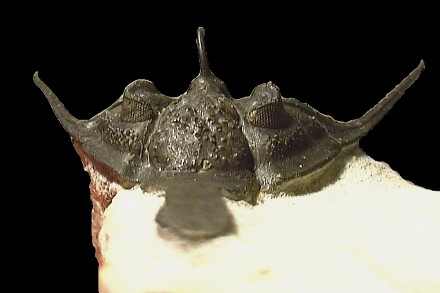 |
 |
|
Frontal view of the cephalon de face. Lack of subocular crest (rim?)
|
Anterior branch of the facial suture.
|
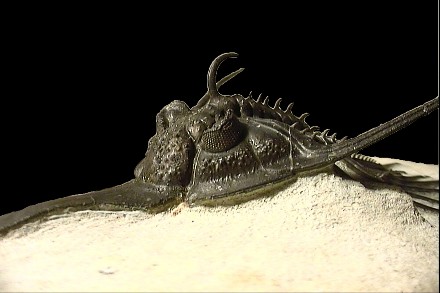 |
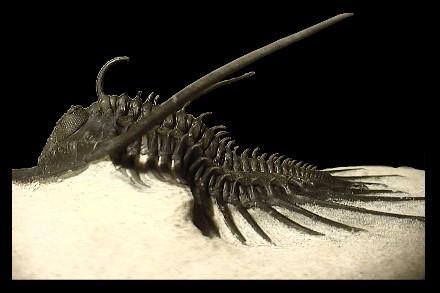 |
|
Palpebral view of the cranidium.
|
Side view of the specimen
|
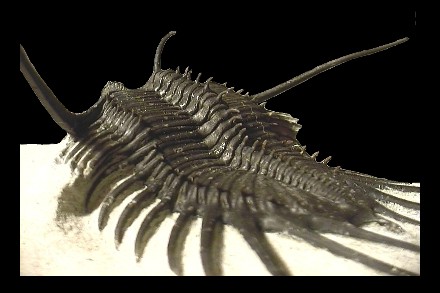 |
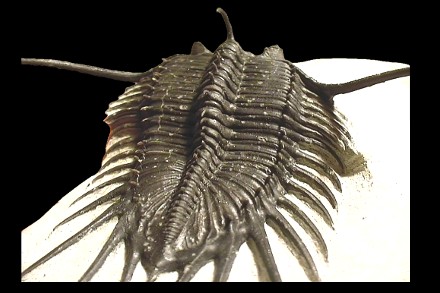 |
|
Right postero-lateral view.
|
Left postero-lateral view.
|
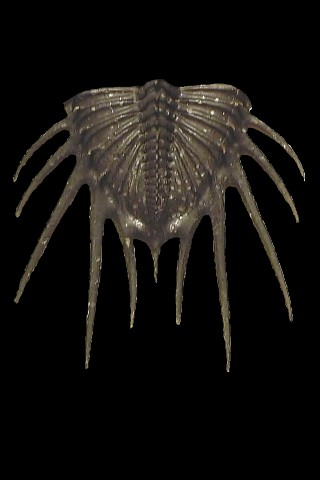 |
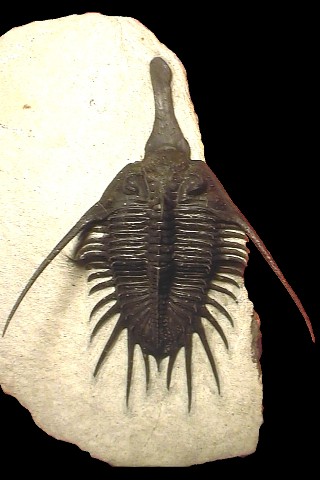 |
|
Dorsal view of the pygidium.
|
Full specimen. Low detail picture due to the contrast
with the matrix.
|
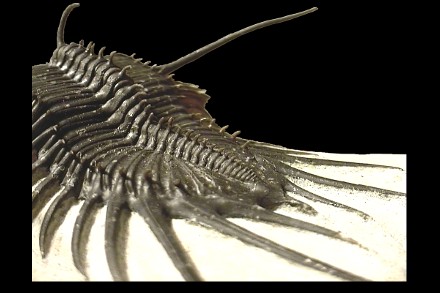 |
|
Terminal posterior piece of the rachis.
|
Original picture :
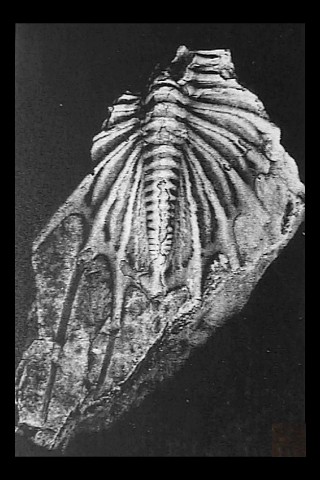 |
|
Dorsal view of the Pygidium. Specimen IGR 10287. Hollard
Coll. (after Morzadec, 1998)
|
References :
MORZADEC P. 1998. Le genre Psychopyge (Trilobita) dans
le Dévonien inférieur du Nord de l'Afrique et l'Ouest de l'Europe. Paleontograph.
Abt. A 200 : pp 153 - 161.
MORZADEC P. 2001. Les Trilobites Asteropyginae du Dévonien
de l'Anti-Atlas (Maroc) [Asteropyginae Trilobites from the Devonian of the Anti-Atlas
(Morocco)]. Paleontograph. Abt. A 262 (1/3) : pp 53 - 85.
Back to home
page
